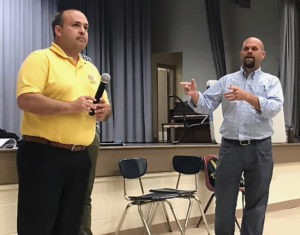
A public meeting on planned updates to the Nadir gut along Turpentine Run gave Army Corps. of Engineers officials the chance to get feedback from local residents and jumpstart a six-month study they hope will unlock approximately $50 million in federal funds for construction.
It’s the first time the Corps. has done a study so quickly, and officials said Wednesday that their goal is to make the project the first to draw from $1.5 billion in federal funds allocated to the Virgin Islands and Puerto Rico under the Bipartisan Budget Act of 2018. Public hearings will continue, comments from residents will be included, but first, the goal is to get the money and then take the time to “sharpen our pencils” and get the details done, said Kevin Whitman, Regional Chief of Planning for the Army Corps’ South Atlantic Division.
The Corps. is still operating on the last study it did for the project about 20 years ago, which will now be reevaluated, said Milan Mora, the organization’s chief of programs and projects within the Antilles region. The recommended plan included: the construction of a 460-foot long concrete “U” shape channel, a drop structure and 170-foot long sheet pile wall along the developed side of the channel, a 260-foot levee along the northern edge of Nadir, a 1,300-foot long levee starting south of the new Bovoni Road Bridge and ending at the Nadir racetrack, and interior drainage conveyance from the existing small concrete channel.
But, there are a few things keeping that from moving forward, the most immediate of which is the construction of the new Nadir bridge, a collapsed retaining wall along the south road and, most importantly, the new development of the racetrack through which, according to the original plan, the water from the neighborhood is supposed to funnel. Mora said the purpose of Wednesday’s meetings and any moving forward is to see what’s changed in the area, analyze the impacts and determine whether the old plan is still feasible.
He also said the timeline for the project is:
– Complete the chief engineering report by July;
– Follow with 18-24 months of design and survey work if that report is approved;
– Acquire lands for the project if necessary;
– Advertise plans and specs for construction in 2021;
– Start construction, which is expected to take 24-36 months to complete; and,
– Wrap up in late 2023-2024.
For the most part, residents attending the meeting were not concerned about the timeline or even the scope of work, as long as there was minimal impact to their houses. However, when Whitman made it clear that the project is meant to deal only with the drainage coming out of Nadir, residents did want to know what the larger plan was for the water flowing through or around other areas. One resident, for example, said she lived right on the edge of the racetrack and is inundated with runoff even in a regular downpour.
Mora said that a levee constructed near that particular property would help, but otherwise, finding a solution to outside runoff is not part of the plan. The remaining gut would continue to run as it historically has, though Mora added that the ongoing public hearing process is meant to generate feedback that could change the scope, or at least indicate to the Army Corps. that the plan needs to be revised.
Attending the meeting Wednesday, Sen. Marvin Blyden asked what the plans are to mitigate drainage in the interim. Mora said the Army Corps. deals with longer term projects, but Federal Emergency Management Agency money has been made available in the past two years to deal with short-term mitigation.
While no one said whether the territory has applied for or been granted the funds, Public Works officials on hand Wednesday did explain that the old “Bridge to Nowhere” will soon be torn down and that would help with clogs and pooling.
One resident questioned Mora’s claim that the project is meant to help the neighborhood withstand a 25-year storm, which he said is far less than what the territory experienced with Hurricanes Irma or Maria. Mora explained that in terms of getting the funding, there is a balance: building for a thousand-year storm like Maria is much more expensive and wouldn’t be approved by Congress, while a smaller project like this would.
Additional information and documentation regarding the project, to include a copy of the 2019 Environmental Assessment and associated appendices, can be found at the Army Corps of Engineers’ website.
Letters of comment or inquiry can be sent no later than April 20 to Kristen Donofrio at Kristen.L.Donofrio@usace.army.mil. or be addressed to the U.S. Army Corps of Engineers, Planning Division — Environmental Branch, Jacksonville District, 701 San Marco Blvd., Jacksonville, Florida, 32207.





